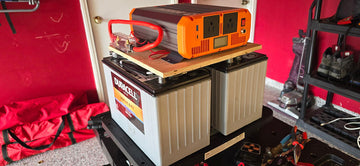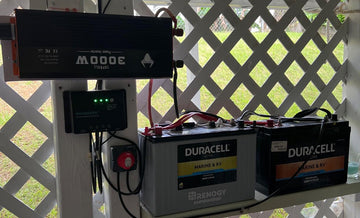Inside this Article:
Principle and Composition of Hybrid Solar System
Hybrid solar system, as the name suggests, is a combination of solar energy and other renewable energy sources (such as wind, water, etc.) as well as energy storage technology integrated energy system. It uses solar panels to convert solar energy into electricity, while combining the complementary nature of other renewable energy sources to achieve a stable supply of energy. Energy storage devices (e.g., battery packs) play a crucial role in the system by storing excess power and releasing it when needed to compensate for fluctuations in energy supply.
Hybrid solar systems typically consist of the following key components:
- Solar panels: As the core part of the system, solar panels are responsible for converting solar energy into electricity. They are made of highly efficient photovoltaic materials and are capable of producing a stable power output under varying light conditions.
- Other renewable energy equipment: According to specific application scenarios and needs, hybrid solar systems can be equipped with wind power generators, small-scale hydroelectric equipment, etc., in order to realize a diversified supply of energy.
- Energy storage equipment: Energy storage equipment is an important part of the hybrid solar system, they can store excess power and release it when needed. Common energy storage devices include battery packs, supercapacitors, etc.
- Intelligent management module: Intelligent management module is the "brain" of the hybrid solar system, which is responsible for monitoring the operating status of the system, and intelligently adjusting the operating parameters of each device according to the energy supply and demand, in order to realize the optimal utilization of energy.
Advantages of Hybrid Solar System
Hybrid solar system has many advantages over traditional energy systems:
- Stable energy supply: Hybrid solar system combines a variety of energy technologies to provide a stable supply of electricity under different conditions. Even in the case of bad weather or poor energy conditions, the continuity of power supply can be guaranteed.
- Environmentally friendly and energy efficient: Hybrid solar systems utilize renewable energy sources such as solar power to generate electricity, reducing reliance on fossil fuels and lowering greenhouse gas emissions, which is important for environmental protection.
- Economical and efficient: Although the initial investment of hybrid solar system is relatively high, in the long run, its operation cost is low, and the energy supply is stable and reliable, which has good economic benefits.
- Intelligent management: The hybrid solar system is equipped with an intelligent management module, which is able to monitor the system's operating status in real time and make intelligent adjustments according to the actual situation, improving the system's operating efficiency and reliability.
Application Scenarios of Hybrid Solar System
Hybrid solar system has a wide range of application prospects, can be applied to the following scenarios:
- Power supply in remote areas: In remote mountainous areas, islands and other areas with no grid coverage or unstable grid, hybrid solar system can provide stable and reliable power supply for local residents.
- Home energy system: Home hybrid solar system can provide clean and stable power supply for families, reduce dependence on traditional energy sources and lower energy costs at the same time.
- Enterprise Energy Solutions: Enterprises can adopt hybrid solar systems as an energy solution to reduce energy costs, improve energy utilization efficiency, and show the environmental image of the enterprise at the same time.
- Power supply for public facilities: Hybrid solar systems can also be applied to the power supply systems of public facilities such as schools and hospitals to provide stable and reliable power for these facilities.
Best Hybrid Solar System Kit Recommendation
Kit Includes:
- 12 x 100W Solar Panels
- 1 x 100A MPPT Solar Charge Controller
- 1 x Panel-Controller Cables
- 1 x Controller-Battery Cables
- 4 x Solar Extension Cables
- 1 x MMMMF+FFFFM Connectors
- 12 x Set of 4 Z-Brackets & Hardware
Key Features:
- Efficient energy conversion: The use of high performance monocrystalline silicon solar panels is capable of achieving energy conversion efficiencies of up to 21% in bright weather conditions, ensuring maximum utilization of solar energy resources.
- Independence and Reliability: The off-grid system design makes the system grid-independent and able to provide stable and reliable power support anywhere, especially in remote or off-grid areas.
- Cost Reduction: In the long run, by using solar energy as a free and renewable energy source, energy costs can be significantly reduced, reducing dependence on traditional energy sources and bringing economic benefits to users.
- Environmental Protection and Sustainability: Solar energy is a clean, non-polluting energy source, and the use of the system not only helps to reduce greenhouse gas emissions, but also contributes to the protection of the environment and the realization of sustainable development.
- Flexibility and adaptability: The system can be flexibly configured and customized according to actual needs and site conditions, including the number of solar panels, cable length, mounting brackets, etc., to ensure that it meets the different needs of users.
- Smart management and monitoring: Equipped with an intelligent charge controller and digital display, the system is able to monitor the system's operating status, charging status, battery health and other key data in real time, which is convenient for users to manage and maintain.
- Easy to install and maintain: The system components are well-designed and the installation process is simple and quick, while the maintenance and upkeep are also relatively easy, which reduces the user's follow-up investment and cost.
What is the difference between hybrid solar system, off-grid solar system and grid-connected solar system?
Hybrid solar systems, off-grid solar systems and grid-connected solar systems each have their own unique characteristics and application scenarios, the following are the main differences between them:
1, system composition and working principle:
- Hybrid solar system: combines a variety of energy technologies, such as solar, wind, biomass, etc., as well as an energy storage system (e.g., battery bank). The system is able to operate stably under different energy conditions and achieve optimal utilization of energy through intelligent management modules. For example, when there is insufficient light, power can be supplemented by other energy sources or energy storage systems.
- Off-grid solar system: also known as independent photovoltaic system, it mainly consists of solar cell arrays, off-grid controllers, battery packs, off-grid inverters and other components. The system is not connected to the public power grid and utilizes solar power to generate electricity and store it in the battery during the day, and is powered by the battery at night or on cloudy or rainy days.
- Grid-connected solar system: It is mainly composed of solar cell arrays, grid-connected inverters and some electrical equipment (such as convergence boxes, distribution cabinets, etc.). The system converts solar energy into electricity and then sends the electricity to the grid directly through the grid-connected inverter, which is connected to the public power grid.
2. Power supply and stability:
- Hybrid solar system: Due to the combination of multiple energy technologies and energy storage systems, hybrid solar systems are able to provide a more stable and reliable power supply under various conditions.
- Off-grid solar systems: Power supply is limited by the availability of solar energy and the storage capacity of the batteries, so power supply may be unstable during continuous cloudy days or long periods of no light.
- Grid-connected solar system: The power supply is connected to the public grid and is therefore relatively stable, but the system is unable to provide power in the event of a grid failure or blackout.
3. Application Scenarios:
- Hybrid solar system: suitable for scenarios that require stable power supply and variable energy conditions, such as remote areas and islands.
- Off-grid solar system: applicable to areas without grid coverage or unstable grid, such as remote mountainous areas, grasslands, etc.
- Grid-connected solar system: applicable to the scenarios with stable grid coverage and hope to reduce energy costs, such as households, enterprises, etc.
4. Economy and investment:
- Hybrid solar system: The initial investment may be higher due to the combination of multiple technologies and equipment, but in the long run, it is more economical due to the stability and reliability of energy supply.
- Off-grid solar systems: The initial investment includes the acquisition cost of equipment such as solar panels and batteries, as well as installation and maintenance costs. Costs may be higher due to the need to take care of all power supply on their own.
- Grid-connected solar system: The initial investment is relatively low and consists mainly of the acquisition cost of equipment such as solar panels and grid-connected inverters. The system can recoup some of the investment by selling excess power to the grid.
To summarize, hybrid solar system, off-grid solar system and grid-connected solar system each have their own advantages and disadvantages and applicable scenarios. When choosing one, comprehensive consideration needs to be made based on the actual situation and needs.


















